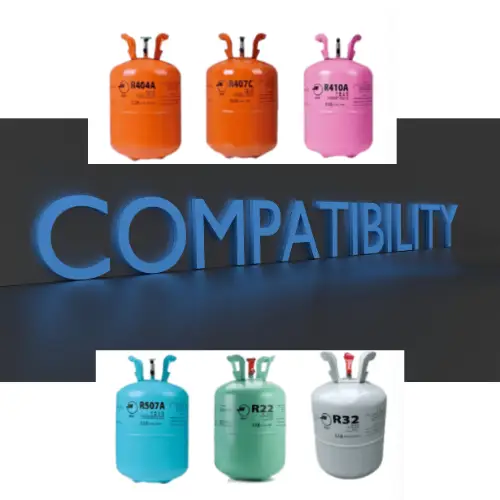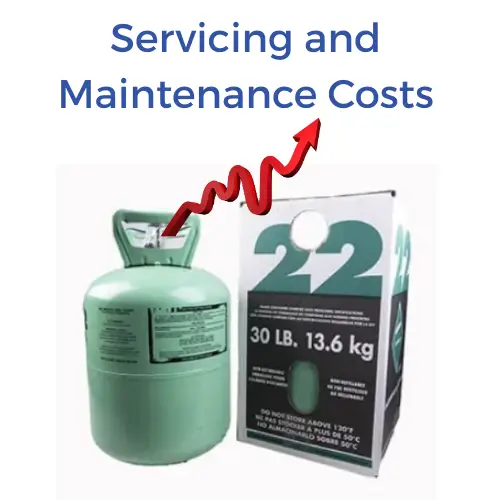As a homeowner, it's important to understand the refrigerant used in your air conditioning system and how industry changes may impact you. The type of refrigerant can affect the efficiency, cost, and environmental impact of your HVAC equipment.
Refrigerants are the chemical compounds that facilitate the heat transfer process in air conditioners and heat pumps. They cycle between liquid and gas states to absorb heat from inside your home and release it outdoors. The refrigerant type is a key component that affects the overall performance and lifespan of your HVAC system.

The most common refrigerants used in residential and light commercial air conditioning systems include:
R-22 (HCFC-22) This was the standard refrigerant used in air conditioners and heat pumps for decades. However, R-22 has been phased out in the U.S. due to its ozone-depleting properties. Production and import of new R-22 was banned starting in 2020, though existing systems can still be serviced with reclaimed or recycled R-22.
R-410A (HFC Blend) As a replacement for R-22, R-410A is now the most widely used refrigerant in new HVAC equipment. It is an HFC (hydrofluorocarbon) blend that is more environmentally friendly and energy efficient than R-22. R-410A operates at higher pressures than R-22, so systems using it require different compressors and components.
R-32 (HFC) Another emerging refrigerant option is R-32, a single-component HFC that is considered more sustainable than R-410A. It has a lower global warming potential (GWP) and is more energy efficient. R-32 is becoming more common in new air conditioners, especially in Europe and Asia, though adoption in North America has been slower.
R-454B (HFO Blend) This is a relatively new HFO (hydrofluoroolefin) refrigerant blend that is being positioned as a next-generation alternative to R-410A. It has a significantly lower global warming potential while maintaining similar performance characteristics. R-454B is expected to gain more traction as R-410A is phased down.

The refrigerant landscape has been rapidly evolving due to global environmental regulations. In 1987, the Montreal Protocol was established to phase down the production and use of ozone-depleting substances like chlorofluorocarbons (CFCs) and hydrochlorofluorocarbons (HCFCs) like R-22.
This led to the development of HFC refrigerants like R-410A as interim replacements. However, HFCs also have high global warming potential, so they are now being phased down as well under the Kigali Amendment to the Montreal Protocol.
The U.S. is implementing an HFC phase-down through the American Innovation and Manufacturing (AIM) Act, which mandates a 85% reduction in HFC production and consumption by 2036. This will drive the increased adoption of lower-GWP refrigerants like R-32 and R-454B in new HVAC equipment.
These refrigerant changes will have several implications for homeowners with existing air conditioning systems:

If you have an older air conditioner or heat pump, it's a good idea to have it inspected by a licensed HVAC technician (call Abbott Air Inc) to determine the refrigerant type. This will help you understand your options as R-22 becomes scarce and more costly to service.
When it's time to replace your HVAC system, look for units that use lower-GWP refrigerants like R-410A, R-32, or R-454B. These will not only be more environmentally friendly, but may also provide energy savings and longer-term cost benefits.
Be sure to work with a qualified HVAC contractor who is knowledgeable (Abbott Air is licensed and insured) about the latest refrigerant regulations and equipment compatibility. They can help you select the right system for your home and ensure it is properly installed and charged.
Here are some additional questions homeowners often have about air conditioning refrigerants:
Q: What happens if my R-22 system develops a leak?
A: If an R-22 system develops a refrigerant leak, it will need to be recharged. However, as R-22 becomes scarce, the cost to recharge the system will continue to rise significantly. At a certain point, it may make more financial sense to replace the entire HVAC system with new equipment using R-410A or a lower-GWP refrigerant.
Q: Can I just add a different refrigerant to my existing system?
A: No, you should not attempt to "top off" or replace the refrigerant in your HVAC system with a different type. Refrigerants are not interchangeable - using the wrong one can damage the compressor and other components. Any refrigerant changes must be done by a licensed HVAC technician who can properly evacuate the old refrigerant and charge the system with the appropriate new refrigerant.
Q: How do I know if my HVAC system is R-410A or R-32 compatible?
A: Check the manufacturer nameplate on your outdoor condensing unit. This will indicate the refrigerant type the system is designed for. You can also consult with your HVAC contractor, who can assess your equipment and recommend the best refrigerant option if you need to replace the system.
Q: Is there a difference in efficiency between refrigerant types?
A: Yes, the refrigerant's thermodynamic properties can impact the energy efficiency of an HVAC system. In general, refrigerants like R-32 and R-454B have demonstrated improved efficiency compared to R-410A. This can translate to lower utility bills for homeowners.

Staying Informed on HVAC Refrigerant Changes As the HVAC industry continues its transition to more environmentally friendly refrigerants, it's important for homeowners to stay up-to-date. Work closely with a qualified HVAC contractor who can advise you on the best options for your home comfort system. With the right information, you can make informed decisions that benefit both your wallet and the planet.
Disclaimer: The information provided on this website' and blog is for general informational purposes only. All information on the blog is provided in good faith, however, we make no representation or warranty of any kind, express or implied, regarding the accuracy, adequacy, validity, reliability, availability, or completeness of any information on the site. We encourage our readers to conduct their own research and due diligence. The website and its authors are not liable for any errors or omissions in this information nor for the availability of this information. Any action you take upon the information you find on this blog is strictly at your own risk. The content may change over time, and some information may become outdated after the time of publication. We are not responsible for the views, opinions, or accuracy of facts referenced in our articles, as they are meant for informational purposes only.
By sharing we can help family and friends that might need future Air Conditioning Services. We are currently working within Venice, Englewood, North Port and surrounding areas with plans to expand further. Please feel free to share from our social media platforms mentions below.
FACEBOOK:
Come join us on Facebook where we share weekly events and happenings. Stay up-to-date with us on Facebook!

INSTAGRAM:
Our brag rights are all posted to Instagram and we hope you will enjoy the photos and reels shared on here!
